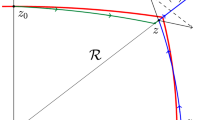Abstract
In the stability analysis of large-scale interconnected systems it is frequently desirable to be able to determine a decay point of the gain operator, i.e., a point whose image under the monotone operator is strictly smaller than the point itself. The set of such decay points plays a crucial role in checking, in a semi-global fashion, the local input-to-state stability of an interconnected system, and in the numerical construction of a LISS Lyapunov function. We provide a homotopy algorithm that computes a decay point of a monotone operator. For this purpose we use a fixed-point algorithm and provide a function whose fixed points correspond to decay points of the monotone operator. The advantage over an earlier algorithm is demonstrated. Furthermore, an example is given which shows how to analyze a given perturbed interconnected system.
Similar content being viewed by others
References
Berge C (1997) Topological spaces. Dover, Mineola
Bourlès H (2000) Addendum to: “w-stability and local input-output stability results”. IEEE Trans Autom Control 45(6): 1220–1221
Bourlès H, Colledani F (1995) w-stability and local input-output stability results. IEEE Trans Autom Control 40(6): 1102–1108
Dashkovskiy SN, Ito H, Wirth FR (2011) On a small gain theorem for ISS networks in dissipative Lyapunov form. Eur J Control 17(4): 357–365
Dashkovskiy SN, Kosmykov M, Wirth FR (2011) A small gain condition for interconnections of ISS systems with mixed ISS characterizations. IEEE Trans Autom Control 56(6): 1247–1258
Dashkovskiy SN, Rüffer BS (2010) Local ISS of large-scale interconnections and estimates for stability regions. Syst Control Lett 59(3–4): 241–247
Dashkovskiy SN, Rüffer BS, Wirth FR (2007) An ISS small gain theorem for general networks. Math Control Signals Syst 19: 93–122
Dashkovskiy SN, Rüffer BS, Wirth FR (2010) Small gain theorems for large scale systems and construction of ISS Lyapunov functions. SIAM J Control Optim 48: 4089–4118
Eaves BC (1972) Homotopies for computation of fixed points. Math Program 3: 1–22
Evans LC (1998) Partial differential equations. In: Graduate studies in mathematics, vol 19. American Mathematical Society, Providence
Geiselhart R (2010) Homotopy algorithms and the numerical construction of ISS Lyapunov functions. Master’s thesis, Universität Würzburg, Germany
Ito H, Jiang ZP (2009) Necessary and sufficient small gain conditions for integral input-to-state stable systems: a Lyapunov perspective. IEEE Trans Autom Control 54(10): 2389–2404
Jiang ZP, Lin Y, Wang Y (2004) Nonlinear small-gain theorems for discrete-time feedback systems and applications. Automatica 40(12): 2129–2136
Jiang ZP, Mareels IMY, Wang Y (1996) A Lyapunov formulation of the nonlinear small-gain theorem for interconnected ISS systems. Autom J IFAC 32(8): 1211–1215
Jiang ZP, Teel AR, Praly L (1994) Small-gain theorem for ISS systems and applications. Math Control Signals Syst 7(2): 95–120
Karafyllis I, Jiang ZP (2010) New results in trajectory-based small-gain with application to the stabilization of a chemostat. Int J Robust Nonlinear Cotrol. doi:10.1002/rnc.1773
Karafyllis I, Jiang ZP (2011) A vector small-gain theorem for general non-linear control systems. IMA J Math Control Inf 28(3): 309–344
Liu T, Hill DJ, Jiang ZP (2009) Lyapunov formulation of ISS small-gain in dynamical networks. In: Proceedings of 48th IEEE CDC/28th CCC 2009, pp 4204–4209, Shanghai, China
Merrill OH (1972) Applications and extensions of an algorithm that computes fixed points of certain upper semi-continuous point to set mappings. PhD thesis, University of Michigan, East Lansing
Moylan P, Hill D (1978) Stability criteria for large-scale systems. IEEE Trans Autom Control 23(2): 143–149
Rüffer BS (2010) Monotone inequalities, dynamical systems, and paths in the positive orthant of Euclidean n-space. Positivity 14(2): 257–283
Rüffer BS (2010) Small-gain conditions and the comparison principle. IEEE Trans Autom Control 55(7): 1732–1736
Rüffer BS, Dower PM, Ito H (2010) Applicable comparison principles in large-scale system analysis. In: Proceedings of the 10th SICE annual conference on control systems. Kumamoto, Japan
Rüffer BS, Wirth FR (2011) Stability verification for monotone systems using homotopy algorithms. Numer Algorithms 58:529–543
Saigal R (1977) On the convergence rate of algorithms for solving equations that are based on methods of complementary pivoting. Math Oper Res 2: 108–124
Šiljak DD (1979) Large-scale dynamic systems. In: North-Holland series in system science and engineering, vol 3. North-Holland, New York
Smith HL (1995) Monotone dynamical systems: an introduction to the theory of competitive and cooperative systems. In: Mathematical surveys and monographs, vol 41. American Mathematical Society, Providence
Sontag ED (1989) Smooth stabilization implies coprime factorization. IEEE Trans Automat Control 34(4): 435–443
Sontag ED, Wang Y (1995) On characterizations of the input-to-state stability property. Syst Control Lett 24(5): 351–359
Tarjan R (1972) Depth-first search and linear graph algorithms. SIAM J Comput 1: 146–160
Vanderbei RJ (1996) Linear programming—foundations and extensions. Kluwer, Boston
Vidyasagar M (1981) Input-output analysis of large-scale interconnected systems. In: Lecture notes in control and information sciences, vol 29. Springer, Berlin
Yang Z (1999) Computing equilibria and fixed points. Kluwer, Boston Dordrecht London
Author information
Authors and Affiliations
Corresponding author
Rights and permissions
About this article
Cite this article
Geiselhart, R., Wirth, F. Numerical construction of LISS Lyapunov functions under a small-gain condition. Math. Control Signals Syst. 24, 3–32 (2012). https://doi.org/10.1007/s00498-012-0082-2
Received:
Accepted:
Published:
Issue Date:
DOI: https://doi.org/10.1007/s00498-012-0082-2




